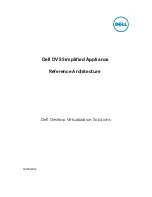
Known Limitations of MySQL Cluster
1528
• Durability of commits.
There are no durable commits on disk. Commits are replicated, but there
is no guarantee that logs are flushed to disk on commit.
• Replication.
Replication is not supported.
Note
See
Section 17.1.5.3, “Limits Relating to Transaction Handling in MySQL
Cluster”
, for more information relating to limitations on transaction handling in
NDB
.
17.1.5.7. Limitations Relating to Performance in MySQL Cluster
The following performance issues are specific to or especially pronounced in MySQL Cluster:
• Range scans.
There are query performance issues due to sequential access to the
NDB
storage
engine; it is also relatively more expensive to do many range scans than it is with either
MyISAM
or
InnoDB
.
• Reliability of
Records in range
.
The
Records in range
statistic is available but is not
completely tested or officially supported. This may result in nonoptimal query plans in some cases.
If necessary, you can employ
USE INDEX
or
FORCE INDEX
to alter the execution plan. See
Section 13.2.8.3, “Index Hint Syntax”
, for more information on how to do this.
• Unique hash indexes.
Unique hash indexes created with
USING HASH
cannot be used for
accessing a table if
NULL
is given as part of the key.
17.1.5.8. Issues Exclusive to MySQL Cluster
The following are limitations specific to the
NDBCLUSTER
storage engine:
• Machine architecture.
The following issues relate to physical architecture of cluster hosts:
• All machines used in the cluster must have the same architecture. That is, all machines hosting
nodes must be either big-endian or little-endian, and you cannot use a mixture of both. For
example, you cannot have a management node running on a PowerPC which directs a data node
that is running on an x86 machine. This restriction does not apply to machines simply running
mysql
or other clients that may be accessing the cluster's SQL nodes.
• Adding and dropping of data nodes.
Online adding or dropping of data nodes is not currently
possible. In such cases, the entire cluster must be restarted.
• Backup and restore between architectures.
It is also not possible to perform a Cluster
backup and restore between different architectures. For example, you cannot back up a cluster
running on a big-endian platform and then restore from that backup to a cluster running on a little-
endian system. (Bug #19255)
• Online schema changes.
It is not possible to make online schema changes such as those
accomplished using
ALTER TABLE
or
CREATE INDEX
, as the
NDB Cluster
engine does
not support autodiscovery of such changes. (However, you can import or create a table that
uses a different storage engine, and then convert it to
NDB
using
ALTER TABLE tbl_name
ENGINE=NDBCLUSTER
. In such a case, you must issue a
FLUSH TABLES
statement to force the
cluster to pick up the change.)
• Binary logging.
MySQL Cluster has the following limitations or restrictions with regard to binary logging:
•
sql_log_bin
[494]
has no effect on data operations; however, it is supported for schema
operations.
• MySQL Cluster cannot produce a binlog for tables having
BLOB
columns but no primary key.
Summary of Contents for 5.0
Page 1: ...MySQL 5 0 Reference Manual ...
Page 18: ...xviii ...
Page 60: ...40 ...
Page 396: ...376 ...
Page 578: ...558 ...
Page 636: ...616 ...
Page 844: ...824 ...
Page 1234: ...1214 ...
Page 1427: ...MySQL Proxy Scripting 1407 ...
Page 1734: ...1714 ...
Page 1752: ...1732 ...
Page 1783: ...Configuring Connector ODBC 1763 ...
Page 1793: ...Connector ODBC Examples 1773 ...
Page 1839: ...Connector Net Installation 1819 2 You must choose the type of installation to perform ...
Page 2850: ...2830 ...
Page 2854: ...2834 ...
Page 2928: ...2908 ...
Page 3000: ...2980 ...
Page 3122: ...3102 ...
Page 3126: ...3106 ...
Page 3174: ...3154 ...
Page 3232: ...3212 ...
















































